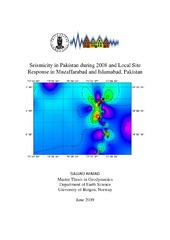Seismicity in Pakistan during 2008 and Local Site Response in Muzaffarabad and Islamabad, Pakistan
Master thesis
Permanent lenke
https://hdl.handle.net/1956/7220Utgivelsesdato
2009-06-02Metadata
Vis full innførselSamlinger
- Department of Earth Science [1050]
Sammendrag
Pakistan is tectonically significant and thus needs to be studied. In recent years, Pakistan is growing economically and the population has increased. Pakistan has experienced several disastrous earthquakes in the historical times. About 50% of the population is living under a constant earthquake threat. This results in raising the interest to estimate the seismic hazard through tectonic and seismological studies. Present study has been divided into two parts. Comparison of Pakistan seismic network data (limited available) with international data from PDE and conducted a local site effects study in the two cities (Islamabad and Muzaffarabad) of Pakistan. The first part describes the seismicity, tectonics of Pakistan, Seismic Network in Pakistan (past, present and future) along with comparison of Pakistani seismic network data with international data from PDE with respect to epicentral earthquakes locations and magnitudes. Fifty four earthquakes detected by both PDE and seismic network of Pakistan are relocated. It has been observed that epicentral locations (PDE and Pakistan seismic network) of the earthquakes do not fit well in general. Another attempt made by selecting comparatively good event from local network but again resulting in the more or less similar difference in epicentral locations of earthquakes calculated by the PDE and local network. Magnitude comparison of the two (PDE and Pakistan seismic network) shows that the local magnitude (Ml) calculated by the Pakistan seismic network is quite close to the PDE (body wave magnitude), coda magnitude calculated by the Pakistan seismic network data is giving high value as compared to PDE magnitude. In the second part local site effects in the two cities of Pakistan have been conducted. It has been realized by the seismological society that most of the damage associated with earthquakes could be attributed to local site effects- amplification of the seismic waves from unconsolidated or water saturated loose sediment deposits or the particular topography in the given area. In this study, two sites have been surveyed for site effects- one sector of Islamabad city capital of Pakistan and the Muzaffarabad city, Pakistan. Non reference site technique proposed by Nakamura has been used for the calculation of fundamental site frequencies in several different sites in the area under investigation. The topographic and geological conditions in the two localities are different. In Islamabad area the results observed are roughly in agreement with the existing soil conditions. The fundamental frequencies vary, however they show consistent values in general with the expected sediment thickness and compositions. The data coverage and its distribution were not ideal to give more precision and confidence level. Amplification factors obtained are quite low (2-4) and is evenly distributed for the entire area. In Muzaffarabad, the fundamental frequencies are not clear and vary significantly, this probably due to the nature of the sediments which are mainly coarse grained proximal fluvial deposits are of high energy enrichment It is well known that Pakistan is situated in an earthquake prone area, we believe that the present study may be of use to the Municipality of the two cities to improve the building codes by taking the site effects into consideration.
